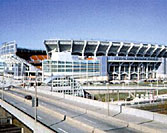Size and Shape

With the increase in the size and capacities of galvanizing installations, facilities now exist for galvanizing components covering a significant range of sizes and shapes.
Duncan’s galvanizing kettle measures 42 feet long by 7 feet deep by 5 feet 2 inches wide. Almost any component can be galvanized by designing and fabricating in modules suitable for available galvanizing facilities. However, it is wise to check kettle size restrictions with your galvanizer at an early stage.
Large structures are galvanized by designing in modules or sub-units. These are then assembled by shop welding or site bolting after galvanizing. Modular design techniques often produce economies in manufacture and assembly because they simplify handling and transport.
When an item is too large for total immersion in the molten zinc of the largest galvanizing kettle available, but more than half of the item will fit into the kettle, one end may be immersed and withdrawn, and then the other end may be galvanized. This is referred to as the double dip process. ALWAYS CONSULT YOUR GALVANIZER BEFORE PLANNING TO USE DOUBLE DIP GALVANIZING.
Large cylindrical objects may be galvanized by progressive dipping. This procedure can be used when the width of the article exceeds that of the kettle. The item is galvanized by using a series of dips or by rolling the article in the molten zinc of the kettle.
The designer should consider the material handling techniques used in galvanizing plants. The use of hoists and cranes is commonplace. Large assemblies are usually supported by chain slings or by lifting fixtures, if provided. Special jigs and racks are often used to galvanize large numbers of similar items simultaneously.
If aesthetics are important provide lifting fixtures for the galvanizer. Since all material is immersed into the galvanizing kettle from overhead, chains, wire or other holding devices will be used to support the material, unless special lifting fixtures are provided. Chains and wire normally leave a mark on the galvanized article. This mark is not necessarily detrimental to the coating but could affect the desired aesthetics.
Large pipe sections, open top tanks and similar structures may require the addition of cross stays to maintain their shape during handling.
Although ‘size’ normally brings large items to mind, the smaller items should also receive attention. The galvanizing process can treat small items by racking. Pieces less than about 15 inches (38.1cm) in length are frequently galvanized in perforated baskets. The basket is then centrifuged to throw off excess zinc from the pieces and provide smoother coatings. Fasteners, small brackets and clips typify work handled in baskets.
The heavy weight of fabrications can be a factor in galvanizing-largely because of the handling required to move items step to step. Thus, weight-handling capacity of your galvanizer should be determined, if it appears this might be a factor in your design considerations.
